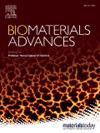Cationic lipopolymer based siRNA delivery for experimental lung cancer treatment
IF 6
2区 医学
Q2 MATERIALS SCIENCE, BIOMATERIALS
Materials Science & Engineering C-Materials for Biological Applications
Pub Date : 2025-06-18
DOI:10.1016/j.bioadv.2025.214394
引用次数: 0
Abstract
Conventional therapeutic approaches often struggle to address “undruggable” or intracellular targets, limiting their effectiveness in treating critical diseases. RNA interference (RNAi), particularly through the delivery of short interfering RNAs (siRNAs), has emerged as a promising alternative. In this study, we evaluated the potential of a series of cationic lipopolymers, including ALL-Fect, Leu-Fect, and Prime-Fect, for delivering siRNAs targeting CDC20, Survivin, and STAT5 in lung cancer cell models. These polymers exhibited strong siRNA binding (BC50: 0.17 ± 0.04 to 1.67 ± 0.31) and dissociation (DC50: 57.9 to 13.6 U/mL) properties, forming nanoparticles with ζ-potential of −15 to +23 mV, and particles sizes of 150 to 400 nm suitable for efficient cellular uptake, achieving over 75 % FAM-positive cell populations in lung cancer cells. Remarkably, these complexes demonstrated significant cell killing effects with specific siRNAs even at a low siRNA concentration (20 nM), with maximal effects observed at a polymer/siRNA ratio of 5:1 ratio and 40 nM siRNA concentration, resulting in over 75 % cell killing. The performance of lipid nanoparticles (LNPs) for the delivery of the specific siRNAs was minimal compared to the lipopolymeric carriers under similar conditions. These findings underscore the potential of lipopolymers as safe and effective non-viral vectors for siRNA-based lung cancer therapeutics.
基于阳离子脂聚合物的siRNA递送用于实验性肺癌治疗
传统的治疗方法往往难以解决“不可药物”或细胞内靶点,限制了它们在治疗危重疾病方面的有效性。RNA干扰(RNAi),特别是通过传递短干扰RNA (sirna),已经成为一种有前途的替代方法。在这项研究中,我们评估了一系列阳离子脂聚合物的潜力,包括all - effect、leu - effect和prime - effect,在肺癌细胞模型中递送靶向CDC20、Survivin和STAT5的sirna。这些聚合物具有较强的siRNA结合(BC50: 0.17±0.04至1.67±0.31)和解离(DC50: 57.9至13.6 U/mL)特性,形成的纳米颗粒的ζ-电位为- 15至+23 mV,颗粒尺寸为150至400 nm,适合于有效的细胞吸收,在肺癌细胞中实现超过75%的fam阳性细胞群。值得注意的是,即使在低siRNA浓度(20 nM)下,这些复合物也显示出对特定siRNA的显著杀伤作用,在聚合物/siRNA比为5:1和siRNA浓度为40 nM时观察到的最大效果,导致超过75%的细胞杀伤。在类似条件下,脂质纳米颗粒(LNPs)递送特定sirna的性能与脂质聚合物载体相比是最低的。这些发现强调了脂聚物作为基于sirna的肺癌治疗安全有效的非病毒载体的潜力。
本文章由计算机程序翻译,如有差异,请以英文原文为准。
求助全文
约1分钟内获得全文
求助全文
来源期刊
CiteScore
17.80
自引率
0.00%
发文量
501
审稿时长
27 days
期刊介绍:
Biomaterials Advances, previously known as Materials Science and Engineering: C-Materials for Biological Applications (P-ISSN: 0928-4931, E-ISSN: 1873-0191). Includes topics at the interface of the biomedical sciences and materials engineering. These topics include:
• Bioinspired and biomimetic materials for medical applications
• Materials of biological origin for medical applications
• Materials for "active" medical applications
• Self-assembling and self-healing materials for medical applications
• "Smart" (i.e., stimulus-response) materials for medical applications
• Ceramic, metallic, polymeric, and composite materials for medical applications
• Materials for in vivo sensing
• Materials for in vivo imaging
• Materials for delivery of pharmacologic agents and vaccines
• Novel approaches for characterizing and modeling materials for medical applications
Manuscripts on biological topics without a materials science component, or manuscripts on materials science without biological applications, will not be considered for publication in Materials Science and Engineering C. New submissions are first assessed for language, scope and originality (plagiarism check) and can be desk rejected before review if they need English language improvements, are out of scope or present excessive duplication with published sources.
Biomaterials Advances sits within Elsevier''s biomaterials science portfolio alongside Biomaterials, Materials Today Bio and Biomaterials and Biosystems. As part of the broader Materials Today family, Biomaterials Advances offers authors rigorous peer review, rapid decisions, and high visibility. We look forward to receiving your submissions!

 求助内容:
求助内容: 应助结果提醒方式:
应助结果提醒方式:


